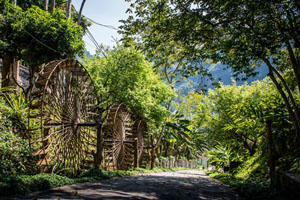
(HBO) – The Muong Culture Space Museum is located in a small limestone valley in Hoa Binh city, about 70km from Hanoi. Forgetting the busy daily life, we went to this place to see why many people leave noisy urban areas to come here at weekends or holidays to live in a peaceful environment close to the life of Muong people. Not at all dry as the image that the name "museum” often suggests, visitors to the place will find themselves in a lively space close to the nature.
The 5ha
Muong
Culture
Space
Museum, established in 2007, is covered by the
green of Wedelia chinensis plants. The plant’s small yellow flowers, which are
in blossom the whole year, especially in spring, line the small paths, creating
a poetic scenery. The museum’s staff also use these flowers to decorate
reception desks and the lounge, giving visitors a fresh and relax atmosphere.

A corner of Muong Culture Space Museum
Welcoming us were the museum’s staff
and guides who looked graceful in Muong women’s traditional costumes, along
with painter Vu Duc Hieu who devoted his youth and assets to study and
establish the
Muong
Culture
Space
Museum. Hieu gave us the first impression of a man
of few words with melancholy eyes. Though he is called Hieu "Muong”, Hieu is
actually of the majority Kinh ethnic group and born in
Hanoi. In 2000, he graduated the
Hanoi
Industry
University in the glass
technology major. He has a strong attachment to Hoa Binh as he grew up in the
province and is engulfed by the unique Muong culture.
The
Muong
Culture
Space
Museum is divided into two areas: one for
reproductions and the other for display. Currently, the museum is preserving
about 3,000 objects and many valuable books on Muong culture. Hieu spent 10
years collecting these exhibits.
The museum is built as a miniature of
the Muong society with four stilt houses corresponding to four different social
strata. The first place to visit is the Lang house, demonstrating the life of the
landlord class. After the Lang house is the Au house of the Lang’s servants,
the Noc house of the commoners, and then the Noc Troi house of the lowest class
in the Muong society.

The
Muong
Culture
Space
Museum attracts a lot of domestic and foreign
visitors
Our journey through both the
reproduction and display areas at the museum ended at sunset. A dinner with
typical dishes of the Muong was ready for us to enjoy.
This was also an attraction for
tourists when visiting the museum, where they can not only learn about the Muong
culture but also enjoy Muong dishes and sleep in stilt houses, which makes the
place ideal for a short holiday or on weekends. Visitors, especially those
coming here for the first time, are sure to be impressed by such dishes as
steamed forest vegetables, grilled fish, hot steamed glutinous rice and Muong
wine. If you are lucky to come in the right season, there are some unique
specialties such as ant egg or bee larvae.
We will definitely come back to the
museum to enjoy the environment and cuisine of the Muong people again.
Hai
Yen
With an increasingly vibrant and widespread emulation movement aimed at building cultured residential areas and cultured families, Yen Thuy District has been making steady progress toward improving both the material and spiritual well-being of its people, while fostering a civilized, prosperous, beautiful, and progressive community.
Once lacking recreational spaces and community facilities, Residential Group 2 in Quynh Lam Ward (Hoa Binh City) has recently received attention for the construction of a new, spacious, and fully equipped cultural house. The project followed the model of state support combined with public contributions in both labor and funding.
The "All people unite to build cultural life" movement, which has been effectively integrated with Kim Boi district’s socio-economic development goals, is fostering a lively spirit of emulation across local residential areas, hamlets, villages, public agencies, and enterprises. In addition, through the initiative, traditional cultural values are being preserved and promoted, while community solidarity and mutual support in poverty reduction and economic development are being strengthened.
A working delegation of the Hoa Binh provincial People’s Committee led by its Permanent Vice Chairman Nguyen Van Toan on June 11 inspected the progress of a project to build the Mo Muong Cultural Heritage Conservation Space linked to tourism services in Hop Phong commune, Cao Phong district.
Born and growing in the heroic land of Muong Dong, Dinh Thi Kieu Dung, a resident in Bo town of Kim Boi district, in her childhood was nurtured by the sweet lullabies of her grandmother and mother. These melodies deeply imprinted on her soul, becoming an inseparable part of her love for her ethnic group's culture. For over 20 years, this love for her hometown has driven Dung to research, collect, and pass down the cultural values of the Muong people to future generations.
In the final days of May, the Ethnic Art Troupe of Hoa Binh Province organized performances to serve the people in remote, mountainous, and particularly disadvantaged areas within the province. These were not just ordinary artistic shows, but they were the meaningful journeys aimed at spreading cultural values, enhancing the spiritual life of the people and contributing to the preservation of ethnic minority cultural identities.




